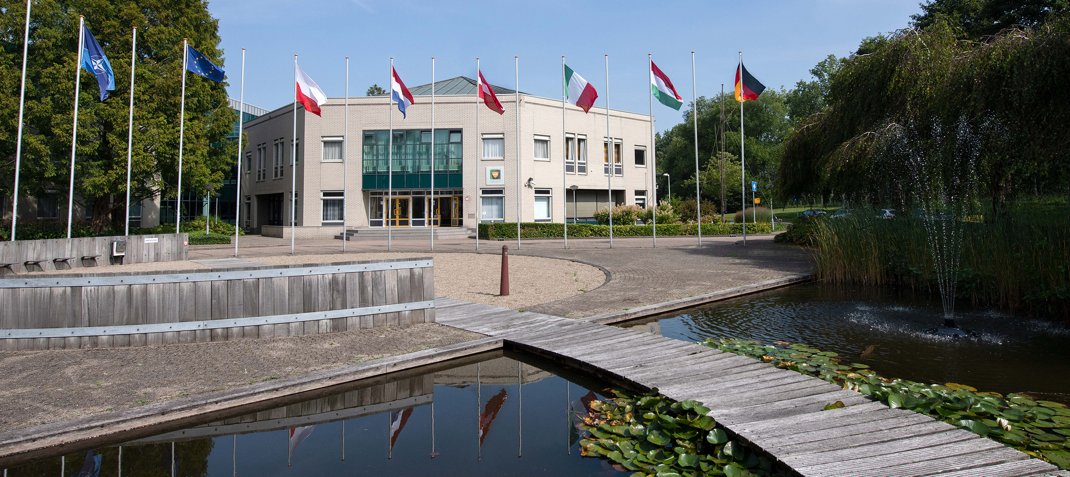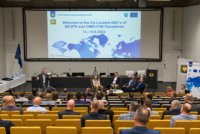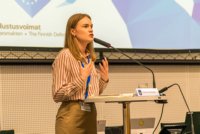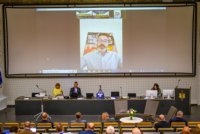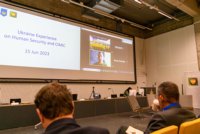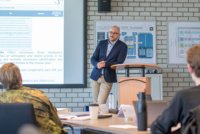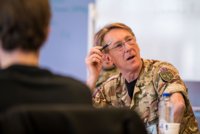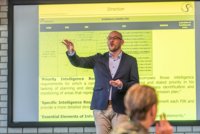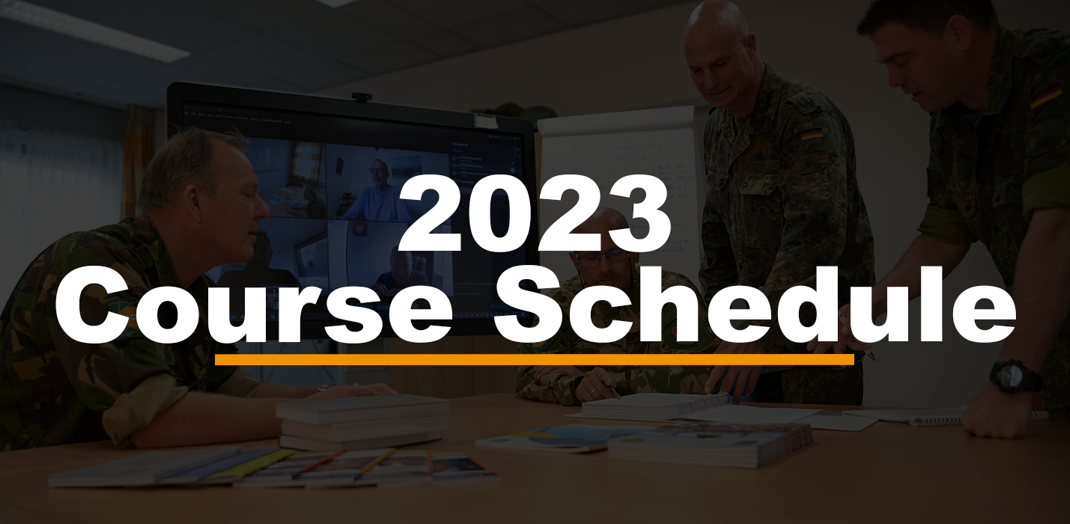CIMIC Messenger 2023-08
Dear CIMIC Community,
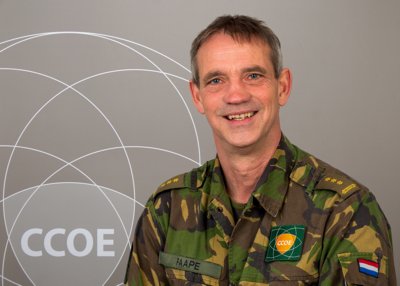
It is my pleasure to introduce the first CIMIC Messenger 2023 to you at the half of the year. Like in our previous CIMIC Messengers, we aim to provide relevant and interesting articles worth reading and I encourage you to do so.
Looking to the security developments in the world, the Russian aggression against Ukraine is continuing, tensions in the Asian region are rising, stability in the Sahel region is decreasing with an enormous speed and in the Middle East there is no lasting solution for peace and stability in range. Besides these factors, there is much more going on in all relevant domains like economy, ecology, social just to name a few. All these developments have their influence on the military, nations and civil societies and thus for defining and conducting civil-military cooperation - CIMIC.
NATO is speeding up with planning and preparing for credible deterrence and defence of the Euro-Atlantic Area as a major conflict in Europe, bordering NATO Allies, is still going on. The Alliance has grown due to the new NATO member Finland and Sweden is closely following to join as well. Also other major threats to security and stability – like economic crisis, energy and migration challenges need to be taken into account by NATO and EU, too.
With the renewal of AJP 3.19, it takes CIMIC on the joint function level clearly into the focus.
This means that CIMIC is a commanders’ responsibility and requires commitment and contribution above and beyond ACOS J9 and the CIMIC Branch.
This is supported by conceptual and doctrinal developments on top-level such as the Multi Domain Operations and Comprehensive Approach definitions. An article in this messenger will elaborate on that topic
Within the Concepts, Interoperability, Capabilities branch, new developments are in a continuing process of assessing if adaptation is needed. Subsequent we keep you and the wider CIMIC Community of Interest posted.
The CCOE education and training area is continuing with the CIMIC courses and next to this we participate in exercises by having influence in scenario development and seeing the adaptation of CIMIC not only in the planning but also into execution. Observations which lead to lessons identified will be brought back to the doctrine element to assess if doctrine and concepts should be adapted.
The personnel carousel moved as well at the CCOE. The branch chiefs Support and Training & Education rotated and in September also the Concepts, Interoperability, Capabilities branch as well as the Budget & Finance section will have a new chief. Beside that the normal rotation of personnel affected more positions of the CCOE. The USA Civil Affairs liaison officer to the CCOE will remain for the upcoming months and I am confident this will be extended furthermore to support and facilitate the still increasing CIMIC and Civil Affairs synchronization.
For the upcoming period the ongoing Russian aggression to Ukraine will offer more insights in how CIMIC is handled by and applied in Ukraine and also will challenge CCOE for more dedicated exercise support. Next to this the capability to assess and integrate civil factors, new aspects of resilience and Military Contribution to Human Security (MC2HS) as a new approach to the cross cutting topics will guide the development of our/ CCOE’s contributions and products. The increasing requests for support with mobile training teams and additional and tailored courses are another influencing factor for which I am convinced our calendar will be filled.
At this point I would like to thank the team of the CCOE and the wider group of stakeholders and friends for their continued engagement and support to the mission of the CCOE.
Enjoy reading, make use of the information provided and pass it on. You know where to find us: online, or physically in The Hague, the International City of Peace and Justice!
Best Regards,
Colonel Henk Paape
DEPUTY DIRECTOR CCOE
Photos: PAO CCOE/ A. Döhring, D. Patzke
Topics in this CIMIC messenger
Change of Command at the Multinational CIMIC Command in Nienburg
CCOE Analysis: CIMIC Lessons to be Drawn from the Ukraine War
CIMIC Annual Discipline Conference 2023
Doctrinal development: Revision of AJP-3.19 Allied Joint Doctrine for Civil-Military Cooperation
Integrating the Civil Factors of the Operating Environment
The journey from my CIMIC to our CIMIC
Change of Command
at the Multinational CIMIC Command in Nienburg/Weser.
Colonel Armin Schaus is the new commander
of the (German) CIMIC troops
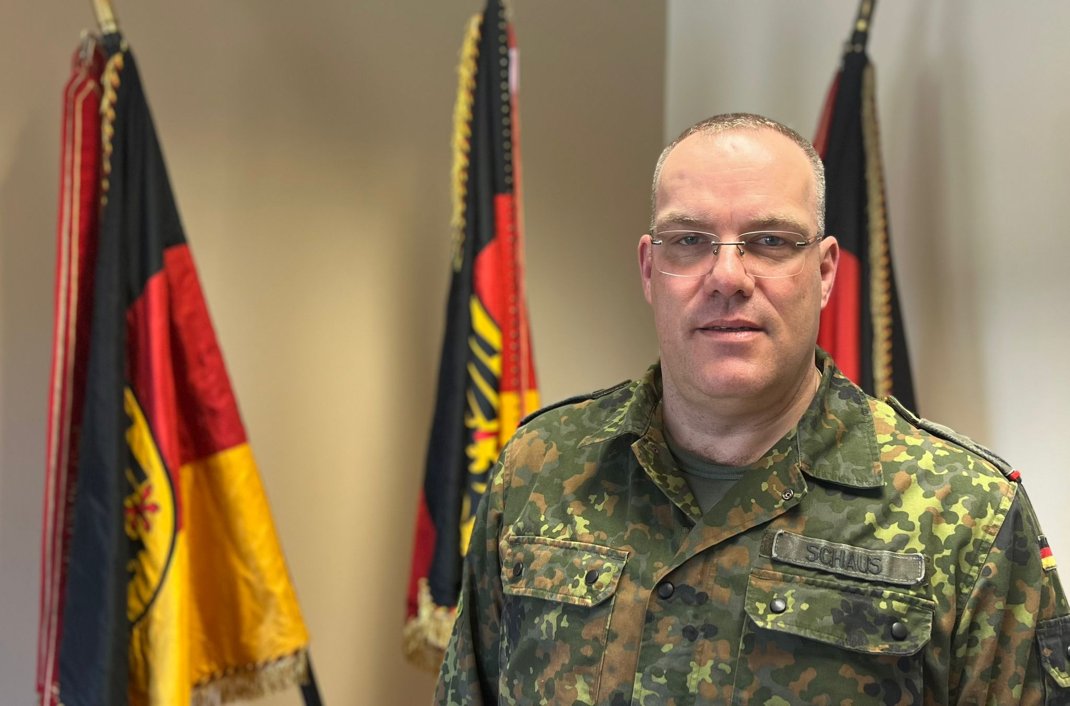
After Colonel Armin Schaus took over command of the Multinational CIMIC Command (MNCC) in Nienburg we would like to introduce this key person of German CIMIC and representative of Germany as a framework-nation of the CCOE, to the CIMIC Community of Interest.
With many years of experience and expertise, Colonel Schaus is no newcomer to the field of civil-military cooperation at all. Already in the staff of the Territorial Tasks Command (DEU: Kommando Territoriale Aufgaben der Bundeswehr) and later in the recently established Homeland Defence Command (DEU: Territoriales Führungskommando der Bundeswehr) of the Bundeswehr, he was deeply involved in the practical implementation of domestic civil- military cooperation (DEU: Zivil- Militärische Zusammenarbeit = ZMZ).
Colonel Schaus, what is important to you as a commander and for your leadership?
I want to create an open and collaborative environment where ideas and suggestions from all ranks and nations are welcome. I want to make sure that all voices are heard and that the different perspectives are used to improve operations in the specialized task. Everyone is encouraged to contribute to the development of best practices actively. For me, an efficient flow of information is of great importance. This can be regulated and organized through different platforms. By this regular exchange, relevant information is shared efficiently. With the understanding of the assignment and the knowledge of background and framework conditions, we achieve more motivated assignment fulfilment in terms of mission command. Communication at all levels is also a core task of CIMIC.
How do you intend to strengthen civil-military cooperation further?
I attach great importance to close cooperation between military and civilian actors. My goal is to strengthen cooperation with local authorities, civil organizations and the civilian population. Improved cooperation ensures that military measures are effectively tailored to the needs and concerns of the civilian population. Here in Nienburg this is already well practiced with regard to the international exercise series JOINT COOPERATION. But this support for the civilian side is not a one-way street. We must also think about and address what support the armed forces and the Bundeswehr need from the civilian side.
Colonel, what do you mean by that in concrete terms?
The entire armed forces must reorient themselves within the framework of the current mission. Until now, missions within the framework of international crisis management have been at the forefront and dominated our mission and training, thinking, and action. With the return of war to Europe, the focus and mission are clearly changing back to deterrence as well as Alliance and national defence. This also clearly influences the core mission of CIMIC. Thinking and organizing national defence affects the whole of Germany and thus also the civilian side.
In addition, Germany, due to its geographical location, is the hub in Europe for many NATO Allies in the context of pre-defence. The transit through Germany and the associated supply, accommodation, and all other support of other NATO Allies not only commit our own forces but must also be coordinated with the civilian side. This is also where our future focus as CIMICs lies, and even more so in close cooperation with the civilian side.
Colonel Schaus, thank you for the insights and your time.
CIMIC AWARD 2023
Institutional Award for Świętokrzyskie Voivodeship Office in Kielce, Poland
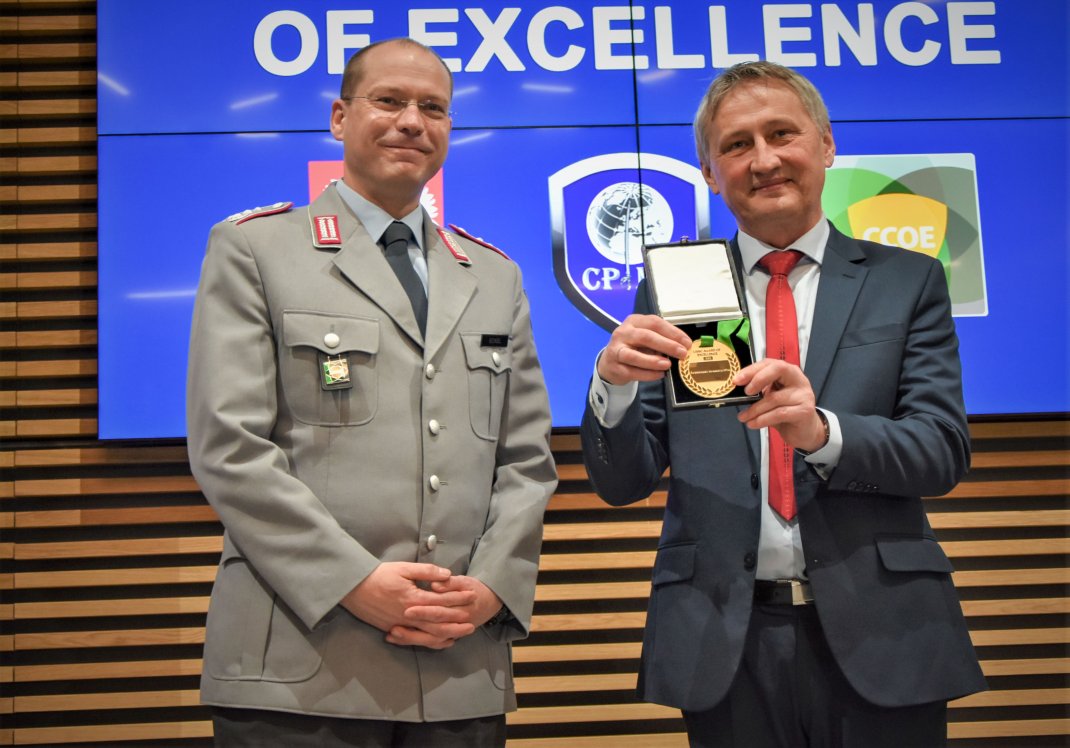
The Office of the Świętokrzyski Voivodeship in Kielce, the regional government situated in Kielce, became the first institution in Poland to receive the prestigious CIMIC Award of Excellence from the CIMIC Centre of Excellence in The Hague. The award has been presented since 2017 and this year the ceremony took place on March 21, 2023. The CIMIC 2023 award goes to us, and this means that civil-military cooperation in our region is a model. In fact, this price simply belongs to the whole of Poland," said the Voivode, the governor, of Świętokrzyskie, Zbigniew Koniusz
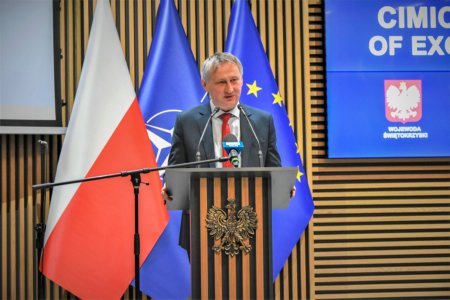
CIMIC stands for civil-military cooperation. It is a term used within NATO structures to describe cooperation between military forces and civil authorities in peacetime, crisis and conflict. CIMIC activities come into play already in peacetime and include host nation support operations, among others. This is a great appreciation for the region and Poland. Świętokrzyskie Voivodeship is a prime example of a strong and well-aligned civil-military partnership.
"That is why we decided to award this region," said Colonel Andreas Eckel, Director of the CIMIC Centre of Excellence
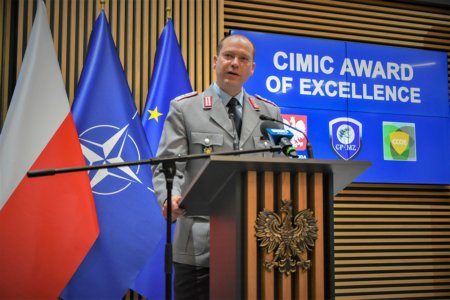
During a parallel event to the CIMIC Award 2023 ceremony in Kielce, the CCOE Director did not miss the opportunity to visit the course and inform himself about the latest developments. During his tour, he was accompanied by Deputy Base Commander LTC Krzysztof Orzech from the Military Training Centre for Foreign Operations and LTC Pawel Polak from CCOE in The Hague.
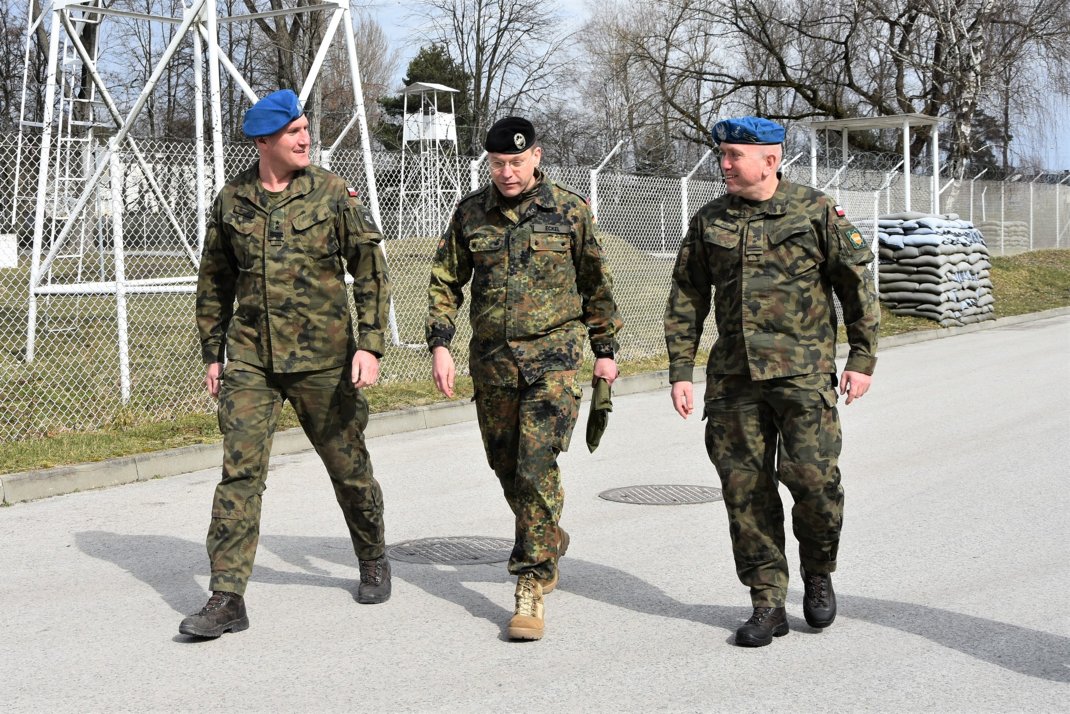
CCOE Analysis: CIMIC Lessons to be drawn from the Ukraine War
The CIMIC Centre of Excellence (CCOE) is currently working on a specific civil-military analysis of the war in Ukraine. Through this analysis, with a particular focus on Civil-Military Cooperation (CIMIC), we aim to identify and extract the main lessons that can be drawn from this complex and challenging large scale conflict. By examining the role of CIMIC in the context of the war in Ukraine, we hope to shed light on the strategies, approaches, and best practices that can be applied in similar conflicts or operations in the future. The analysis seeks to contribute to a deeper understanding of the humanitarian, social, and strategic dimensions of CIMIC and its impact on the overall outcome of conflicts, with the goal of drawing conclusions and subsequent recommendations that might impact NATO CIMIC, thus enhancing the civil and the military layers of resilience as well as deterrence of the whole Alliance.
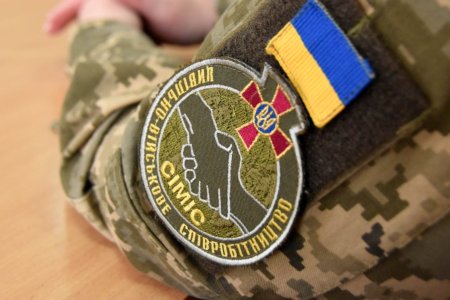
The aim of this analysis is to assist the Alliance in their preparedness considerations and their decision-making processes, prior to, during, and after the deployment of forces, and it is intended to facilitate the planning, design, integration and deployment of CIMIC capabilities in all spheres of a nation’s defence.
Since the 2014 Russian-backed proxy war, NATO refocuses on deterrence and defence as a core task and, although collective defence has always been associated with Article 5 of the North Atlantic Treaty, the current security environment has increased the need for further resilience in civil society, which resulted in renewed focus on Article 3 of the North Atlantic Treaty. Russia’s invasion of Ukraine now displays a scenario, which can be considered as the closest to what NATO can expect from a potential collective defence scenario. It highlights the necessity of preparing adequate responses to shocks, hybrid aggressions and armed attacks that might be inflicted to member states of the Alliance. Therefore, it is crucial for NATO to gather insights, observations, lessons identified and finally draw lessons learned from this war to better understand the impact of military operations on the Civil Environment and vice versa, how civil factors can affect and enhance armed force’s preparedness and resilience in peacetime and their military operations during crisis.
The new definition of CIMIC stresses the relevance of civil factors for the achievement of military strategic objectives in peacetime, crisis and conflict. The outbreak of the war in Ukraine has demonstrated the urgency to also adopt a broader understanding of CIMIC and its need to support preparedness and resilience, not only abroad but also within the territories of NATO nations, and to include upfront a whole of society approach from deterrence to defence.
Russia’s war in Ukraine and the Ukrainian approach to civil military cooperation highlight the need to integrate civil factors in planning and executing military operations and the relevance of CIMIC capabilities. It is crucial to have a comprehensive understanding of the civil environment as a pre-condition for successful operations and integration into holistic efforts.
The paramount role of resilience, understood as a society’s ability to resist and recover easily and quickly from shocks, such as natural disaster, failure of critical infrastructure, or a hybrid up to armed attack, is based on both civil preparedness and military capacities. Resilience represents the linking pin between civil society and the armed forces, therefore it is vital to enhance CIMIC capabilities in NATO countries. Robust, Resilience through Civil Preparedness (RtCP) in Allied nations is essential to NATO’s collective security and reinforces the credibility of NATO’s deterrence and defence. Resilience is first and foremost a national responsibility and each member country needs to be sufficiently robust and adaptable to support the entire spectrum of crisis envisaged by the Alliance but furthermore it contributes to the ability of nations to sustain Alliance activities.
An adversary may use hybrid tactics, before and still during a crisis, to target this resilience or to create conditions that affect the resilience of a nation. To counter these tactics, nations are required to implement a broad spectrum of measures that involve preparation, absorption, recovery, and adaptation. The NATO Resilience Committee and its planning groups have facilitated and supported national efforts in developing regional assessments and sector-specific criteria and guidance to assist national authorities in their effort to meet the ambition established by the Seven Baseline Requirements of Resilience. This has become utmost relevant as the relation between the Alliance and Russia have drifted from cooperation, via competition to harsh confrontation after the Russian Federation has and is frequently violating the international rule’s based order.
This analysis applies the Seven Baseline Requirements of Resilience, and the two additional ones used by Ukraine, to map the civil situation in Ukraine and depicts how Ukraine applies its CIMIC concept. The analysis will support identifying fields for improving CIMIC as a joint function in peacetime, crisis, and conflict and its possible implications on NATO CIMIC framework. By proceeding to assess the role played by CIMIC in Ukraine, NATO has the possibility of gaining important real-life lessons that will, ultimately, contribute to the resilience and the collective defence capabilities of the Alliance.
CIMIC Annual Discipline Conference 2023
Co-located with the Military Contribution to Peace Support (MC2PS) Discipline, located at our newest NATO member in Helsinki, Finland
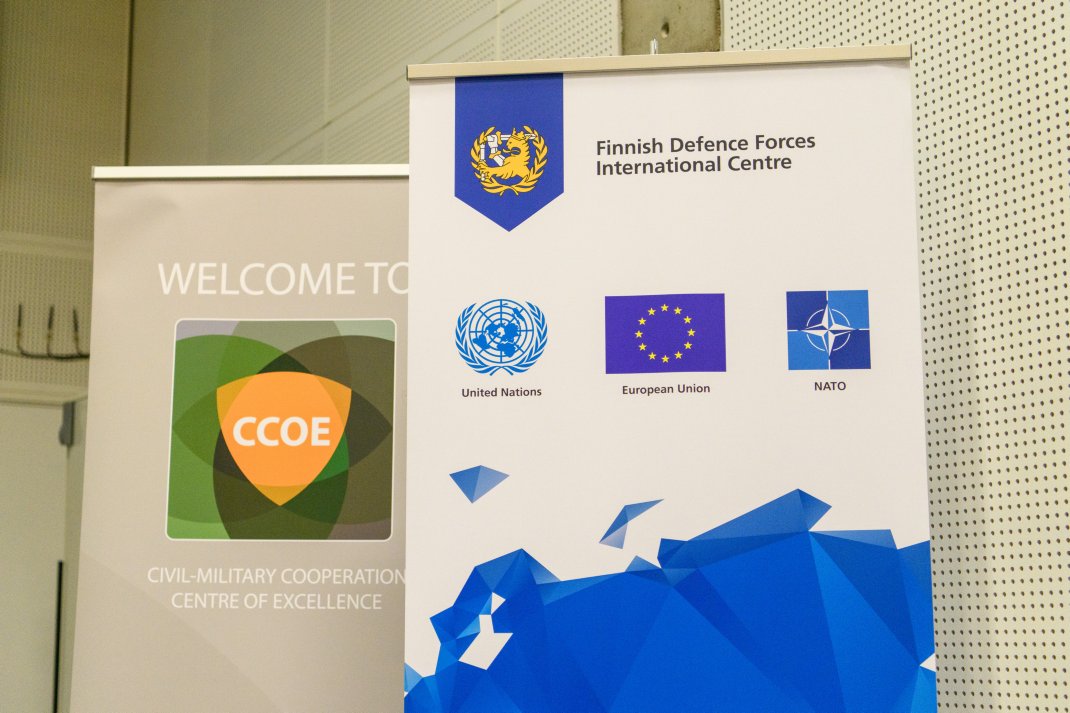
Introduction:
From 13-16 June 2023, the CIMIC Centre of Excellence (CCOE) and Finnish Defence Forces International Centre (FINCENT) successfully executed the Annual Discipline Conference (ADC) in a co-located manner. The ADC is a vital and mandatory annual event within NATO about Education, Training, Exercises and Evaluation (ETEE).
Each of the 28 NATO disciplines presents in their respective yearly conference venue the latest ETEE developments and status of their specific disciplines on ETEE to a Community of Interest within NATO and other stakeholders.
The ADC plays a crucial role in NATO's approach to Training and Education, providing a platform for knowledge sharing and collaboration and offering a crosscheck with the requirement authority from NATO. At this ADC for both disciplines, it is SHAPE ACOS J9, BG Zarka.
The Commandant of FINCENT, Lieutenant Colonel Niclas von Bonsdorff, and the Director of the CCOE, Colonel Andreas Eckel, extended a warm welcome to the communities of interest attending the conference.
Presenting Training Solutions:
The CCOE takes charge of coordinating the training solutions for the CIMIC & CMI Discipline, while FINCENT coordinates the training solutions for the Military Contributions to Peace Support (MC2PS) Discipline. These training solutions are essential for enhancing the capabilities and effectiveness of NATO staff involved in these disciplines. The Requirement Authority, SHAPE ACOS J9, plays a significant role in providing the necessary guidance on training needs and requirements.
Conference Themes and Highlights:
The ADC normally covers a range of topics relevant to the discipline. In this co-located version, the coverage of topics that are important for both disciplines was leading. So Human Security and its military contribution to it, in its broadest sense, was the main topic.
Another highlight was the discussion of NATO's Comprehensive Approach, which showcased the alignment of both disciplines over the past years. Military Contribution to Peace Support (MC2PS) coordinates a workshop for Senior Leaders on Comprehensive Approach. It has been developed by both disciplines, i.e. FINCENT and CCOE, and resembles the overlap in topics next to the will to co-operate on it.
Besides the mentioned subjects, presentations from two speakers from Ukraine were welcomed very warmly, from one representative from NATO HQ in which Partnership developments were key, and via live broadcast with a Ukrainian CIMIC Officer with field experience and out of the field. Their insights and needs provided valuable perspectives and sparked engaging discussions among the participants.
Impressive Participation and Engagement:
The ADC gathered an impressive attendance, with over 80 primarily NATO colleagues and related members of civilian organisations, participating in the conference. This diverse representation fostered rich networking opportunities and fruitful exchanges of ideas, contributing to the overall success of the ADC.
Looking Ahead to 2024:
During this year's ADC, meticulous planning was undertaken for the upcoming year. The 2024 co-located ADCs might see the addition of a third discipline, as the Building Integrity Discipline considers joining the event, possibly in The Hague, at the CCOE.
Scheduled for 4-6 June 2024, this co-located conference will further enhance the multidisciplinary collaboration and knowledge sharing among the participating disciplines – specifically focusing on various elements of the civil factors of the operating environment and its mutual interdependencies and overlaps.
Conclusion:
The co-located Annual Discipline Conference 2023, organised by FINCENT and the CCOE, proved to be a remarkable event for NATO's Training and Education approach. With an extensive range of topics discussed and valuable insights shared, the ADC served as an invaluable platform for enhancing the capabilities and effectiveness of the CIMIC and MC2PS Disciplines. The active participation of NATO colleagues and the engagement of civilian organisations further reinforced the collaborative spirit of the conference. Looking forward to the 2024 ADCs, we anticipate another year of fruitful discussions and progressive development within the NATO community.
Whether the name of the discipline will change to CIMIC instead of CIMIC & CMI will be decided in the course of 2023.
According to the BiSC documentation, the reflection of the discipline will be in each yearly published Discipline Alignment Plan (DAP). The CIMIC & CMI DAP 2023 will be published in Q4 at TRANSNET.
Doctrinal development: Revision of AJP-3.19 Allied Joint Doctrine for Civil-Military Cooperation
NATO’s New Military Strategy is refocussing on Deterrence and Defence while not neglecting the other two NATO core tasks of Crisis Prevention and Management and Cooperative Security. This new focus guides the development of NATO concepts and doctrine in general.
As custodian of CIMIC doctrine, the CCOE is leading the revision process of the NATO CIMIC doctrine: AJP-3.19 Allied Joint Doctrine for Civil-Military Cooperation (CIMIC).
In March 2022, the Allied Command Transformation (ACT) tasked the CCOE to develop a new AJP-3.19 Edition B Version 1.
Since then, a writing team consisting of representatives from several entities of the NATO Command Structure, centres of excellence, and representatives of member nations have developed a solid product ensuring the applicability of the joint function CIMIC across all NATO core tasks. End of July 2023, a further writing team session took place at HQ JFCNP to produce the harmonisation draft as one of the last steps before the ratification of the publication.
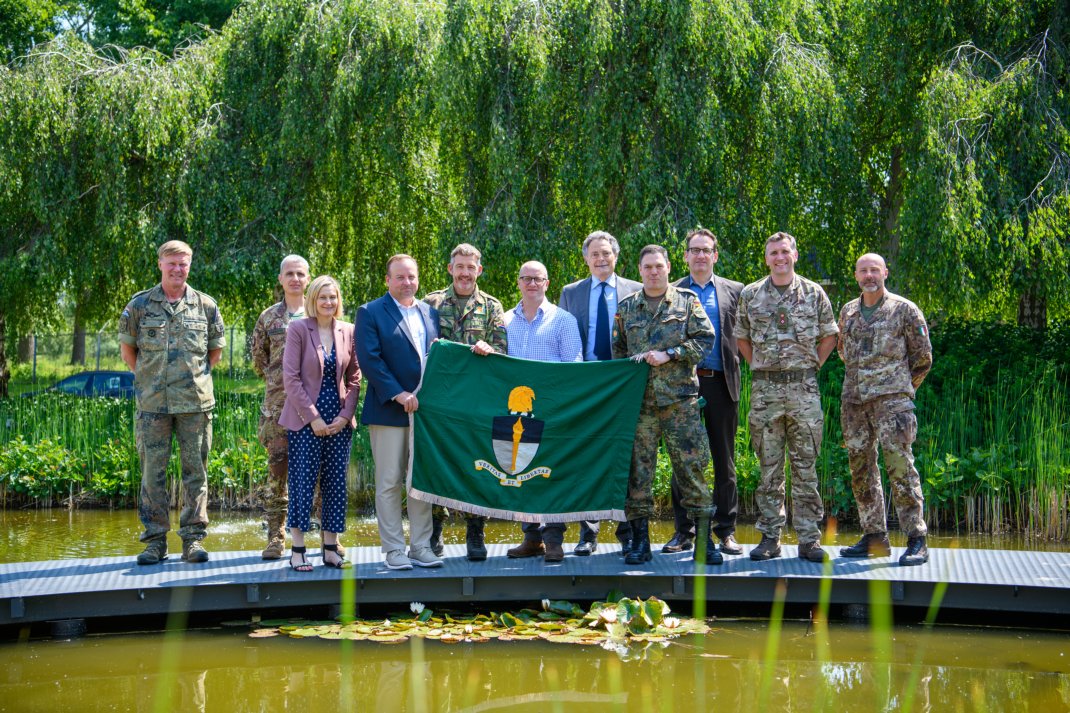
The promulgation – the final endorsement and dissemination – of the new version can be expected in the first half of 2024.
The draft AJP-3.19 describes CIMIC as a joint function, the staff function CIMIC as well as CIMIC capabilities. It replaces the three CIMIC “core functions” with the two “core activities” of CIMIC, which directly derive from the CIMIC definition: “civil-factor integration" (CFI) and “civil-military interaction”(CMI). The newly developed poster “NATO CIMIC Basics” depicts the essentials of the doctrine and guiding principles.
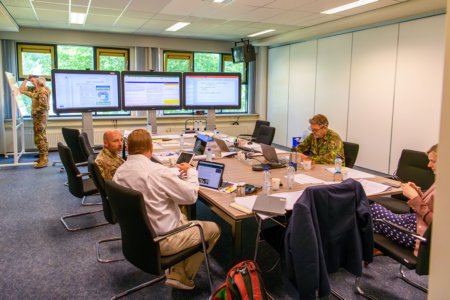
The new definitions of CIMIC and CMI, the new core activities as well as the focus on CIMIC as a Joint Function and its applicability in all NATO Core Tasks constitute significant changes that require a shift of mindset.
The target audience is specifically not only the “J9-community “, but especially Command Groups, D/ACOS-level, and all J-codes. We encourage you to learn more about the revision of the CIMIC doctrine and to proactively spread this in your HQs and units. We are ready to support this and offer our support.
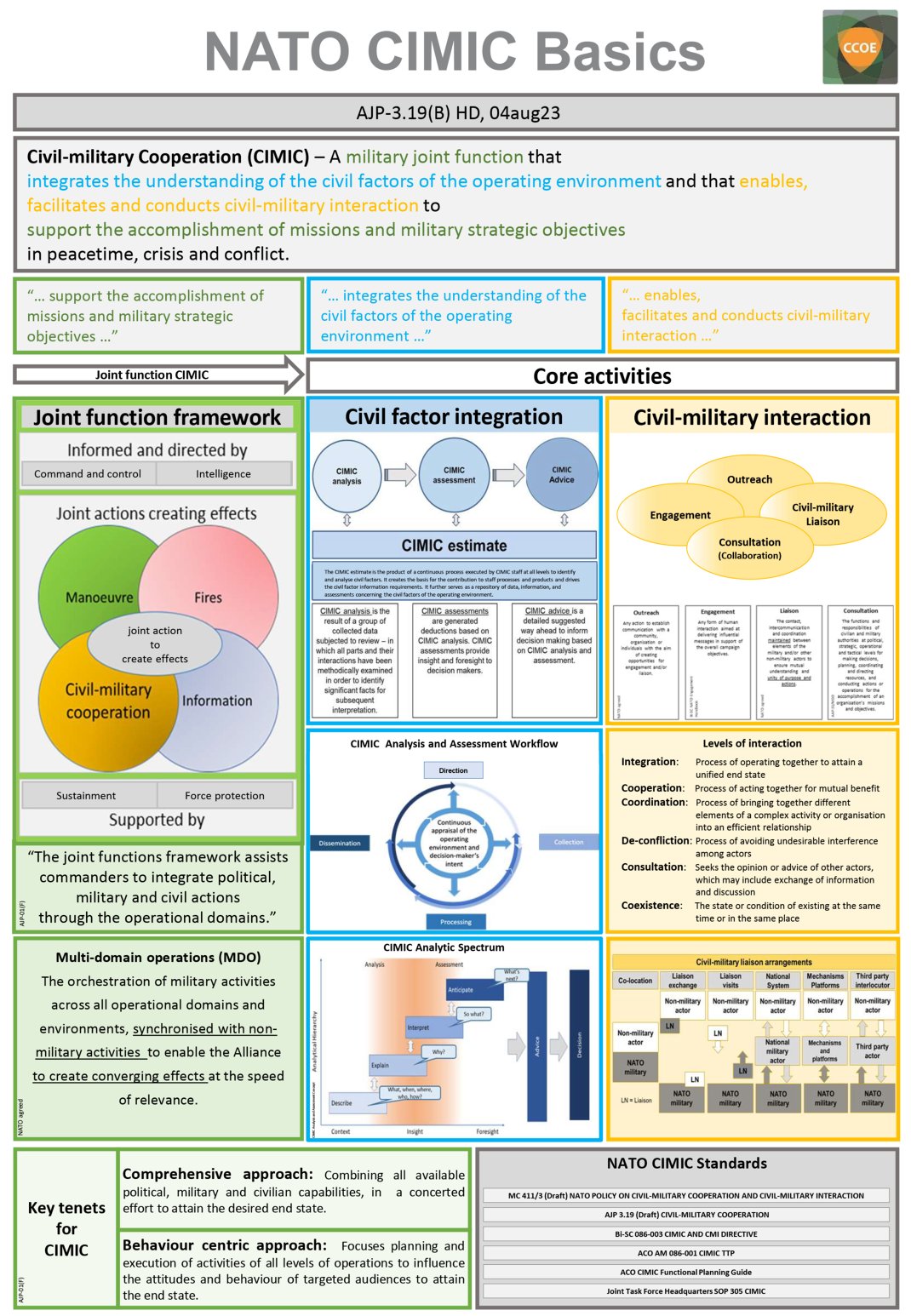
The CIC Branch’s “doctriners” are ready to brief you, your staff, and your leadership – via video conference, at your location, or at the CCOE in The Hague.
Contact the CCOE’s CIC Branch (cic@cimic-coe.org).
Integrating the Civil Factors of the Operating Environment- Civil Factor Integration (CFI)
- A core activity of Civil-Military Cooperation -
“Understanding the operating environment is not limited to military intelligence on the adversary’s forces, perspective and objectives, but rather requires knowledge about non-military actors and their diverse perspectives, and integration of those viewpoints into NATO activities.” Brigadier General Lebrun, (former) ACOS J9, SHAPE
NATO defines Civil-Military Cooperation (CIMIC) as a military joint function that integrates the understanding of the civil factors of the operating environment and that enables, facilitates, and conducts civil-military interaction to support the accomplishment of missions and military strategic objectives in peacetime, crisis, and conflict. Consequently, the responsibility to understand the civil factors of the operating environment is formally registered in this definition. It rests with the Joint Function CIMIC and is nowadays doctrinally referred to as Civil Factor Integration.
The CCOE’s efforts with regard to Civil-Military Analysis and Assessment are in sync with a Supreme Headquarters Allied Powers Europe (SHAPE)-led Strategic Initiative which declared the development of an Allied Command Operations (ACO)-wide Civil-Military Analysis and Assessment capability a priority for NATO. Consequently, in early 2020 the CCOE started to develop a NATO CIMIC Analysis and Assessment concept, aiming to lay down the conceptual foundation for the new capability to arrive at the portfolio of CIMIC.
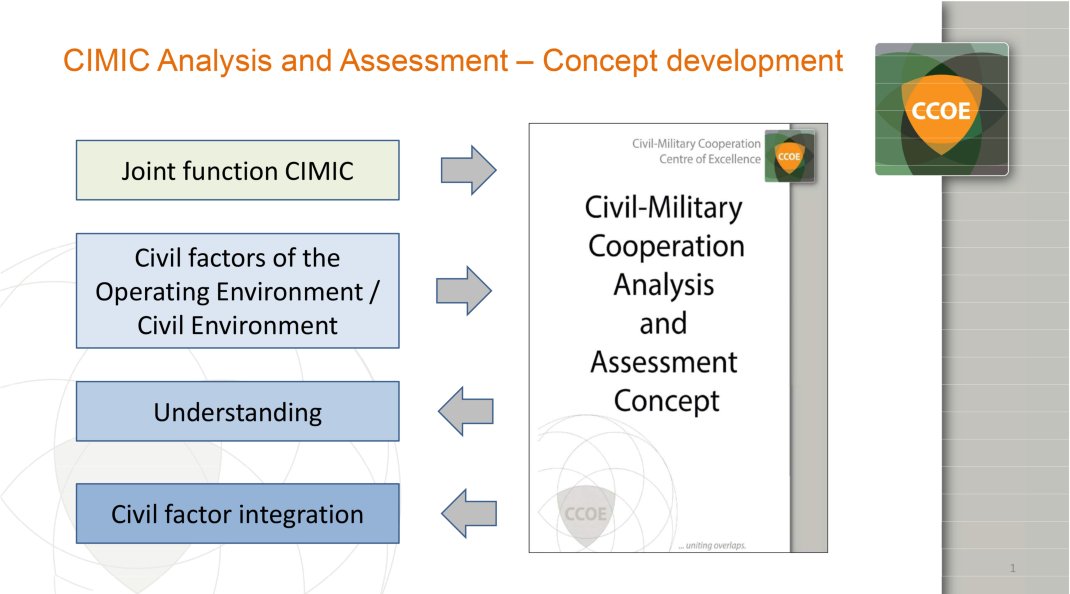
The concept took advantage of the meaningful discussions held while establishing the latest version of the to-come policy on CIMIC and CMI, Military Committee (MC) 411/3, and the subsequent efforts undertaken to renew the Allied Joint Publication (AJP) 3.19, the NATO CIMIC Doctrine. Thus, the concept was able to draw from the fundament build and was able to vice versa enrich the latest CIMIC doctrinal developments.
The concept as such stems from the idea to serve two purposes. It serves on one hand as the conceptual framework introducing terminology and fostering common understanding aiming at a maximum of congruence across the CIMIC doctrinal framework and, on the other hand, as a handbook for those involved in performing CIMIC Analysis and Assessment activities. In other words, the concept is addressing the “Why”, and the “What”, but most importantly the “How” CIMIC Analysis and Assessment is envisaged to be done.
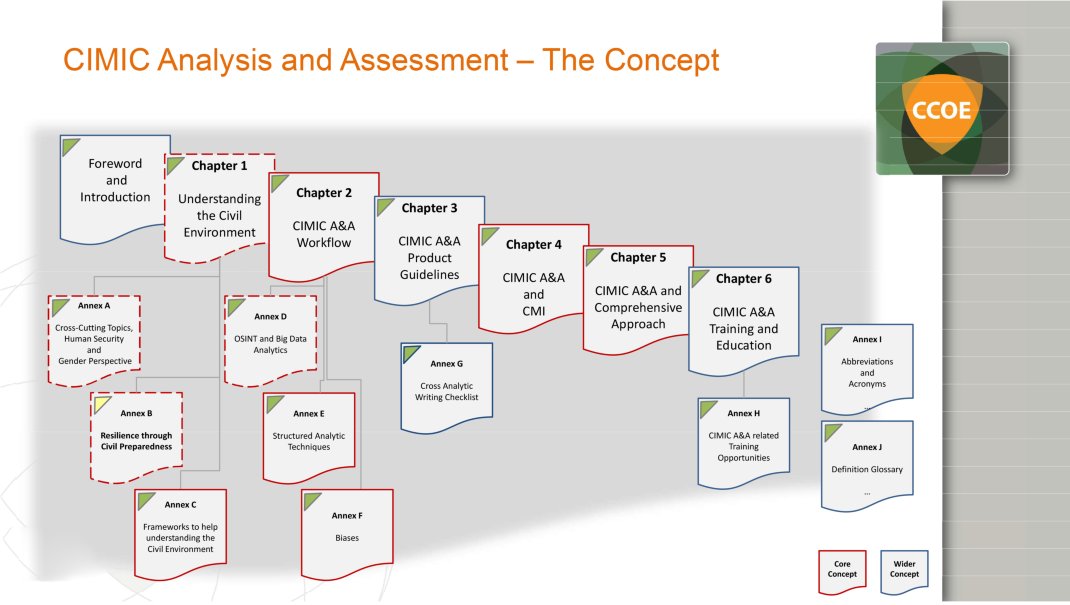
Since December 2022, the CCOE has challenged the concept twice. In December 2022 a “Pilot” course of the NATO CIMIC Analysis and Assessment Course (NCAAC) was carried out. By inviting a curated audience, mainly representing the headquarters, capability commands, and units the Strategic Initiative is directed to, a testbed was created which helped to confirm the concept's nature and content and to explore potential adjustments to the concept, drawn from the expertise and experience represented by the participants.
A final checkup was done in April 2023 with outstanding results. Since then, the NCAAC became the training opportunity corresponding with the concept and an integral part of the CCOE course landscape. The NCAAC is now available for its customers!
The NCAAC conceptualises NATO CIMIC Analysis and Assessment by introducing an analytic spectrum, providing a workflow, and suggesting analytic techniques for CIMIC staff, analysts, and others involved in CIMIC Analysis and Assessment.
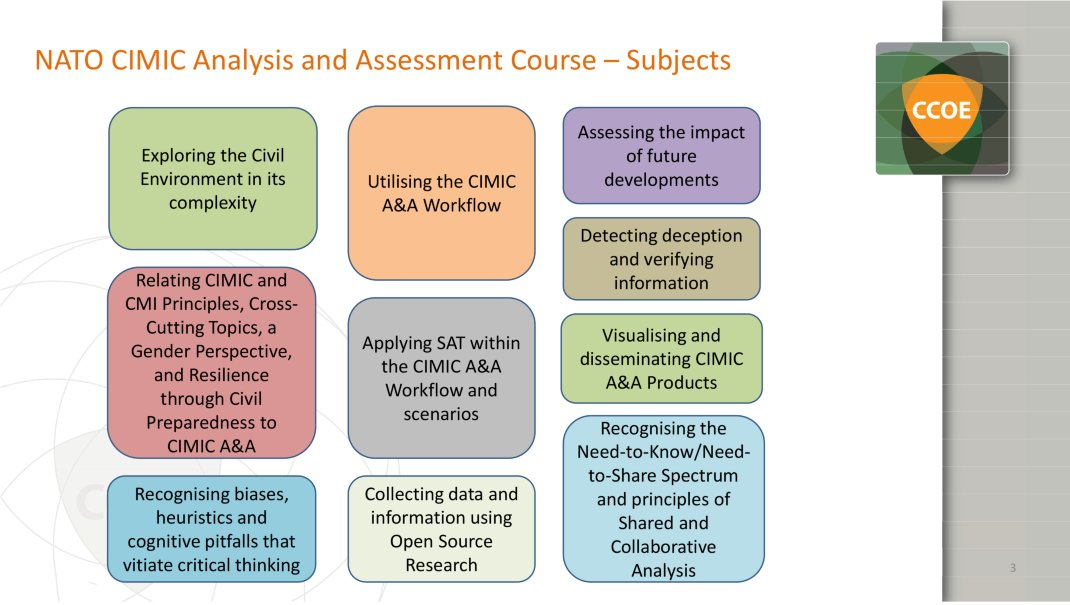
It provides relevant definitions and terminology, explanations, and background information for the analysis of the Civil Environment in NATO’s contemporary operating environment. It explains the CIMIC Analysis and Assessment contribution at the tactical, operational, and strategic levels by a sound training and education solution to achieve long-term skill development and support to decision-making. The course raises awareness of biases in analytic processes and constitutes the necessity to employ Structured Analytic Techniques (SAT) in favour of relevant CIMIC Analysis and Assessment products. It also provides guidelines for the proper visualization and dissemination of CIMIC Analysis and Assessment products. This course also explores the potential of shared and collaborative analysis by navigating the ‘need-to-know - need-to-share’ spectrum.
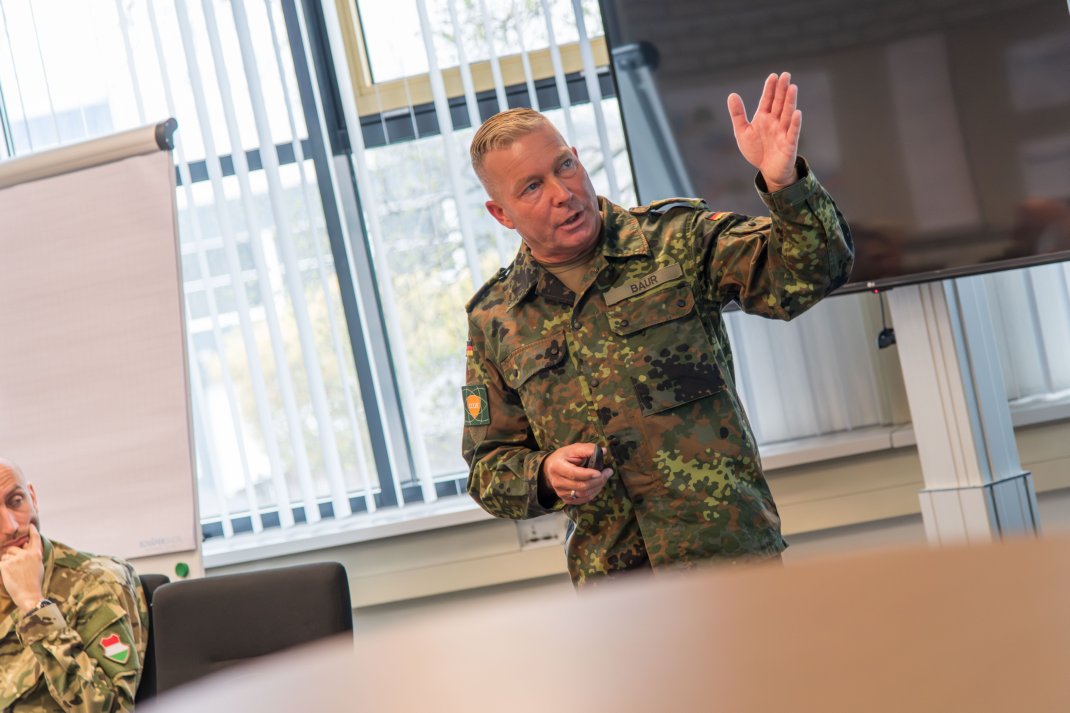
The upcoming months will be characterised by an intense review of the operational requirements arriving from the CIMIC Analysis and Assessment concept, inspiring the CIMIC Analysis and Assessment capability development along the whole spectrum of doctrine, organisation, training, material, leadership, personnel, facilities, and interoperability (DOTMLPFI). CIMIC, as a Joint Function and part of NATO’s Joint Function Framework, assists the commander in integrating political, military, and civil actions through the operational domains. Thus, the leadership responsibilities of integrating the operating environment's civil factors will be given special attention.
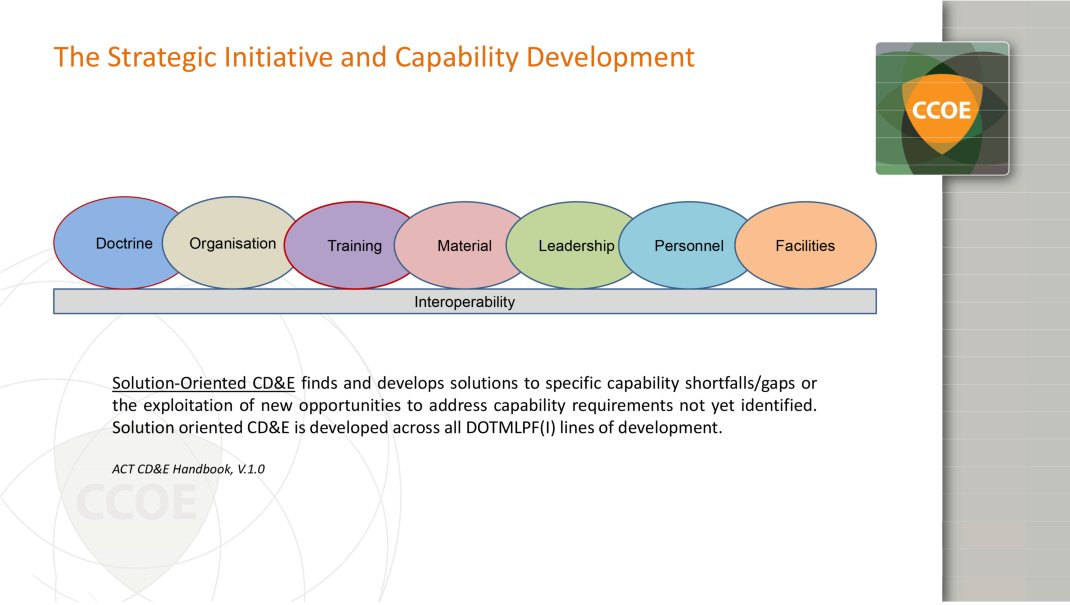
The CCOE will stay committed to the development of the CIMIC Analysis and Assessment capability, enabling the Joint Function CIMIC to perform against the level of ambition expressed by the definition of CIMIC.
Guest Contribution from Mr. Srečko Zajc
(The views and opinions expressed here are those of the author(s) and do not necessarily reflect the official policy or opinion of the CCOE or NATO.)
The journey from my CIMIC to our CIMIC
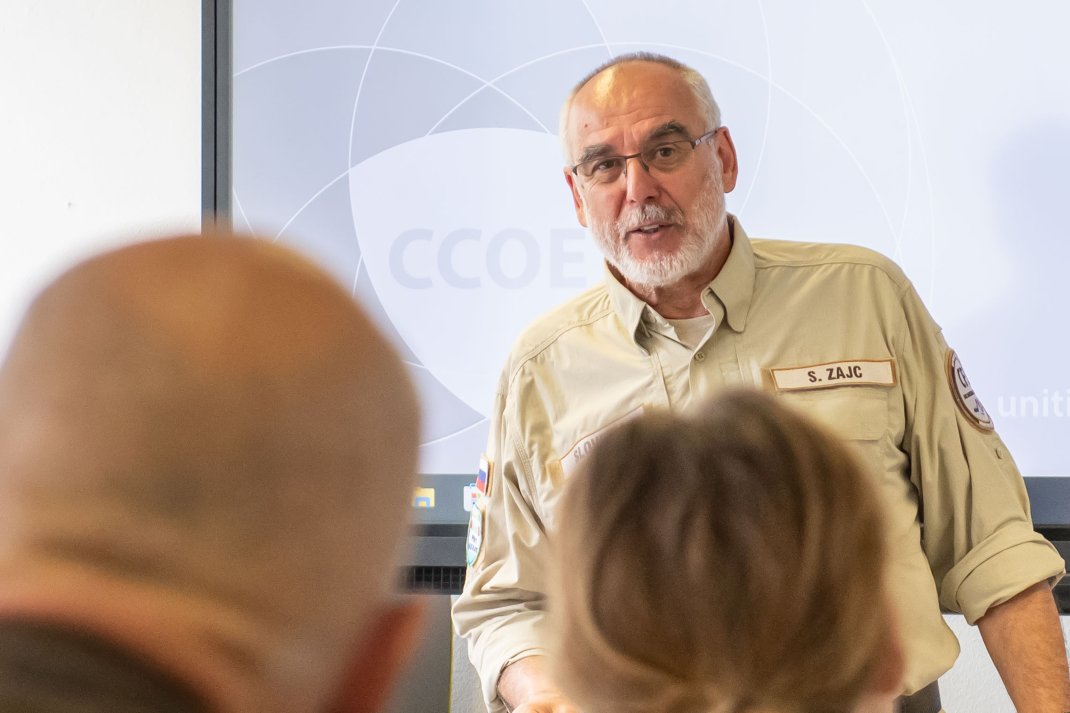
For the first time CIMIC and I met in 2007 when the AJP 9 was already fully operational, and our national Slovenian legislation developed. It wasn't easy and it wasn't completely 'by the book', some improvisations were necessary. Unfortunately, our military didn't show a huge interest in CIMIC so the idea to train, organize and deploy civilian experts was a national push forward, quite unique at that time. At the start, the main domains of CIMIC experts were 3+1: liaison, advice to the commander, advice to the civilian institutions, and small quick impact CIMIC projects to reach 'hearts and minds'. Recognized were three levels – tactical, operational, and strategic and was not uncommon that civilian experts never reached higher than tactical levels.
To climb to the strategic level was always a dream and it remained one even when the discussion within NATO was to integrate military and civilian experts to work as a team starting with the planning process. Unfortunately, this collaboration never happened, and a systematic approach before, during, and after the mission rarely if ever occurred. My assumption is, and it is supported by the excellent Rosa Brooks’ excellency in text How Everything Became War and Military became Everything, that for the military it was a challenge on the palette of their duties to take over some works that in the past were reserved for civilians (humanitarian support to the society, stabilization, reconstruction, and development). The challenge was that by doing civilian business were they neglecting the development of tactics and strategy ? The concern was that the military is best at conducting basic military duties, being the hard tool used to defend and deter. Today, military activities are understood to be a hybrid mixture of more demanding work than that restricted to kinetic only. Military efforts are complex and complicated demanding a new reality that borders life and death.
Until today, the Slovenian CIMIC story remains the same with some brave military exceptions, built on single personal engagements and not because of a systematic approach of our national military. Civil experts since the beginning of CIMIC are called Functional Specialists or CFS. CFS became a label that means something positive or negative depending on context and the person that using the identifier. We transformed the functional specialist role using the space that was provided. What was missing from that space was an adequate response from the military. Irrespective of that missing response, military instructors on their own contributed to designing courses together with many prominent national representatives and other national military and civilian experts (Belgium, Italy, Nederland, France, and Germany). We, the CFSs, were proud of our role even when some high-ranking military and political figures tried to ignore that we even existed.
Despite ups and downs, the CIMIC idea survived, and we wrote our history in Kosovo, Afghanistan, and Northern Macedonia. We are still in Kosovo and writing the future of Bosnia and Herzegovina, plus nowadays interpreters are assisting and training Ukrainian forces. At its peak, the highest number of trained CFSs on a list was over one hundred from different specialties and prepared to be deployed to any NATO mission following the request of any allied nation. This is why in 2007, we were certified during the three-week exercise in Naples, Stead Fast Jaw 2007. We were recognized as useful contributors to any NATO mission and unit. Being trained, organized, and with many necessary basic backgrounds we were the ideal spice to any meal at a tactical level or more complex work on stabilization & reconstruction. During the exercise, we wrote some of the not yet existing NATO manuals and documents guiding CIMIC, i.e., NATO and IDPs and NATO and Protecting cultural heritage manuals.
Our first mission was with the Slovenian battalion in Kosovo, KFOR 2008. Was it a success or failure? The answer depends on one’s approach and understanding of what CIMIC's success and failure are. From the perspective of CIMIC theory and training, our colleagues on the first CIMIC mission achieved a huge success almost without any funds. They were all the time in between the commander’s expectations and the need of a much-divided local community. The expectations of a battalion commander and CIMIC Centre commander did not always adhere to CIMIC theory and the limited resources of CIMIC teams were not always recognized. But, they expected the team to reach the hearts and minds of local populations through gifts like small infrastructure projects, and refurbishing schools, but most of all expecting that teams of CFSs would provide enough funds for their ideas. Of course, they were unable to do that. And the inability to meet commanders’ demands often minimized the value of the CFS within the Slovenian Armed Forces. Certainly, CIMIC was a niche in a small army.
Today, we can say commanders’ weak knowledge of CIMIC and the important contributions it can make to mission success keep military leaders from fully developing their operational environment. Until recently, this picture has not changed. The natural way out of this limbo was to look for open and friendly nations to work with immediately after the first mission. In ISAF they were Italian in PRT Herat, USA in PRT Farah, and ISAF HQ. During many years and in many rotations CFSs performed the real CIMIC on S&R and development. Then we started in NLAT (NAT before) in Kosovo, and we are still today, in the NATO Office in Northern Macedonia CFSs assist in successfully preparing their entrance into NATO (I must point out that in this case cooperation between military representatives as a head of the office and civilian as his supporter and advisor was brilliant).
The idea to join the CCOE and MNCG in Motta di Livenza grew up through our work and the natural need to be a partner in developing CIMIC further. Although the idea came from the civilian half (in reality 90%) of the national CIMIC stock, surprisingly Slovenian Armed Forces took over both positions. Later, after complaining enough to the minister, we got one additional civilian position in MNCG. That wasn’t what we planned but at least it was something. Until today the Slovenian Armed Forces demonstrate that they don’t see any additional value in CIMIC. But we should not forget that representatives came together by chance all those years ago in CCOE and MNCG showed great interest, knowledge, and working discipline to show added value for both institutions. But after returning home they were lost in human resource policy.
The concept of CIMIC or civil-military cooperation exercised, let me use this more military expression, a different phase of evolution, following or walking after new realities. The digital revolution is changing our lives at speeds we never previously encountered. The internet is changing human-to-human and human-to-machine relationships in nanoseconds. Time simply isn’t what it used to be. In the past facts prevailed. Today we fight an ongoing battle of interpretation. Everyone has their own facts, and the result is facts become irrelevant. What matters is opinion. Twitter messages are not facts, they are opinions, and interpretations of the facts, and at the same time pros and cons are running around the Globe pristine information and fake news are on the market since we are a civilization of consumers, we are consuming all that is offered.
We know that information=energy and from the law of physics we know that not even a small piece of energy is lost, it is only transformed, so we may conclude that pristine information is changing in a positive message (defending energy) and fake information in a bad message (destroying energy). Is it the role of the military to ‘fight’ with fake news, cyber-attacks, and hybrid types of adversaries to influence us or our allies? If we still agree that the military is the best when using appropriate strategy and tactics then it is still a lethal force, their essence is lethality. But when speaking about hybrid warfare, when everything is against us war amongst the people posits that the military will do the whole business even if we know that despite enormous investment in a new weapon in the end the human factor is what will decide the end of the story. Besides lethality we need much more utility, said my colleague Scott Buran what is utility? To use for certain work what is the best designed, equipped, prepared, and trained to do that more efficiently. There lies a space for new civil-military cooperation and civil-military interaction. As always, the new territory must be reached, measured, explored, and incorporated into our current way of thinking. And our way of thinking is changing, and it must change permanently and fast. As with colleagues Thomas Matyók and Maj Fritz we were exploring – jazz is the most useful metaphor we have for the type of thinking we need, not that of a symphonic orchestra. Each musician is an expert on his or her own instrument, there is a leading melody that each of them is following, but at the same time contributing to the wholeness through improvisation. Courage for improvisation is a method of current and future warfare and Ukraine is a state full of proof for that (and our Yugoslav and Slovenian history too).
Let me use this not precise word: ‘classical CIMIC’ was an excellent commander’s tool during the operations and missions out of a national or NATO and EU territory. But in a new environment something between ‘out and in’ like Ukraine or in our own national territory we must invent something new. Something like security and defense jazz teams where military and civilians are following the same melody, but they are contributing the best improvisation. It isn’t easy either for the military nor civilians if they do not agree in advance on what ‘musicians’ language they will use. The wall between the military and civilian ways of thinking and operating is high but we must construct doors and windows, it is a need produced by this complex, hybrid, and fluid time. By profession, I am an expert on language / grammatic and literature. Language and grammatic are material and literature is a material organized in improvised form. There is one missing word, it is ‘trust’, trust is the glue between jazz musicians. Civilians do not trust the military, and the military does not trust civilians. It is because they are not using common and understandable language. When the need for deterrence, defense, and protection is on the table we don’t have much time to build up resilience. As much as possible must be done in advance: organization, exercise, education, ‘language’ learning.
And now the most sensitive part of the article: environmental change. Strategy and tactics must change even if the military has become everything it doesn’t mean it is a sufficient force to make our lives safer in an era when everything could be weaponized even the internet. In the past, the internet seems like the panacea for many illnesses of civilization, as it was educating, informing, and forming a citizen of the 20th and 21st centuries. Now citizens are weapons through social media that drive our freedom, democracy, life, and local communities. We don’t feel safe today. Many times, things seem friendly, but it is like a witch from the fairytale of our childhood. To better understand the time we are living in, we need more information from sociologists, anthropologists, historians, neuro-linguists, psychologists, genome researchers, engineers, and all the others they are researching peace and by peace our physical body and our social bodies.
Most peace and CIMIC scholars and practitioners need to be trained in ‘military’ language and later to be positioned as a new class of civil experts within reserve units or within new special civil-military coworking teams. A new type of course could be developed as a pilot, maybe in my country, and after validation, the concept could be dispersed to whoever will see the potential in it. Small and medium-sized states cannot afford to have all new and necessary experts integrated into regular army forces. The time to develop many small USA-like armies is over, the best experts are living and working out of the military, but needs are constantly multiplying. We need something new. In most of the national army forces, they are desperately searching for young people to teach, educate and train them but with almost zero result. So, what to do and how to do it: to reinvent the risky system of conscripts again or to develop new types of hybrid units, civil experts, and military experts coworking when and if necessary. Our rigid defense sector, or even the overall security sector, must be reformed and transformed. Yes, the protection of our life and freedom is the main task of every government but it should be also the obligation, a must do, for each citizen. Security and a safe life can’t be provided by less than 1% of the population – the needs are much bigger, and they will grow. Let us go back to the start: if everything became a war and the military became everything, everyone must defend themself. But each citizen must know how, when, and with whom. As Henry Dunant once stated when he started the idea of a Red Cross – trained and organized individuals recognized by the government as first auxiliary in humanitarian aid, now it is time for trained and organized individuals recognized by the governments as first auxiliary in security and defense. The first responder will remain in the military, an important part of a new system and a new course. But also, the military must be obliged to learn civilian humanitarian and defense language.
Searching for the answers needs teams of well-coordinated experts that are not working in a rigid hierarchy, but they replace C2 with leaders when they are the most competent for certain tasks. Nobody can be an expert for most of the knowledge needed like during Renaissance. The main quality is to share, contribute, and be focused on the task. One task for CIMIC in the future is to educate citizens to become active citizens, trained and organized to defend themselves.
CIMIC experts can and must be an interpreter, trained for that task to interpret between civilians and the military when there will be a need. Two different situations generally might be: civilian support to the military for example at military mobility, host nation support or / baseline requirements, and another one when military support to civilians is needed as during natural or technical disasters, complex crises, or even during a state of emergency. Understanding how civilians and how the military is working is important to avoid unnecessary casualties, and entropically use of resources (human and material) and this is a way to establish better resilience if it was missing in preparation. Both, CIMIC experts and the military must have a clear mandate and they must be well coordinated (not always commanded!) to multiply the effect of scarce resources.
The best option is if CIMIC experts will train citizens during peacetime, prepare, and organize them in their local communities by doing exercises with the military, working on manuals, and spreading the goodwill of new teams, designing, and trained, and organizing to cover most of the contemporary needs in complexity of contemporary security. This is a path to a new Open Security, that we need as new relations and circumstances are demanding. We are responsible and we must do our work. For better Open Security, we need better CIMIC. This is natural evolution regarding the change in a global environment.
I would like to thank my colleague and friend Thomas Matyók for his excellent remarks and for his efforts to translate my non-native ‘English’ into real English.
 Srečko Zajc, MA (Faculty of Art, University of Ljubljana), secretary at the Ministry of Defence, Republic of Slovenia, is a former career journalist, chief editor, manager, and Secretary General of the national Red Cross society. He joined to the MoD in 2008 and developed the Slovenian civilian contribution to ISAF (participating three times on the ground in Afghanistan). Until September 2019, he served as Director General of the Defense Affairs Directorate. Main subjects: Defense planning, Critical Infrastructure Protection, resilience, civilian support to the military, civil-military cooperation and interaction, and recruitment for the SVN Armed Forces. In June 2019, the NATO CCOE awarded him with the CIMIC Award of Excellence. He is a member of Interacta Global Network and Joint Civil-Military Network.
Srečko Zajc, MA (Faculty of Art, University of Ljubljana), secretary at the Ministry of Defence, Republic of Slovenia, is a former career journalist, chief editor, manager, and Secretary General of the national Red Cross society. He joined to the MoD in 2008 and developed the Slovenian civilian contribution to ISAF (participating three times on the ground in Afghanistan). Until September 2019, he served as Director General of the Defense Affairs Directorate. Main subjects: Defense planning, Critical Infrastructure Protection, resilience, civilian support to the military, civil-military cooperation and interaction, and recruitment for the SVN Armed Forces. In June 2019, the NATO CCOE awarded him with the CIMIC Award of Excellence. He is a member of Interacta Global Network and Joint Civil-Military Network.
The CCOE CIMIC Messenger is a publication of the CIMIC Centre of Excellence. Its dedicated aim is to provide a forum or platform for stimulating and presenting innovative and comprehensive thinking on NATO CIMIC-related issues such as Mission experiences, concepts, doctrine or lessons learned. The views and opinions expressed or implied in the CCOE CIMIC Messenger are those of the authors and should not be construed as carrying the official sanction of NATO, of any national armed Forces or those of CCOE.
“See you in The Hague!”
